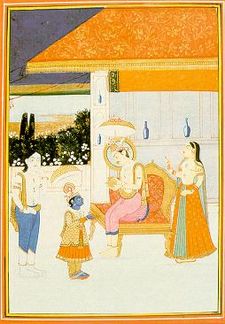బలి పాడ్యమి
బలి ప్రతిపాద ను బలిపాడ్యమి, పాడ్వ, విరప్రతిపాద లేదా ద్యుతప్రతిపాద అని కూడా పిలుస్తారు. ఇది హిందువుల పండుగ దీపావళికి నాలుగు రోజుల తరువాత వచ్చే పండుగ. [1][2] ఈపండుగను దైత్య రాజు బలి చక్రవర్తి భూమిపైకి వచ్చే రొజున జరుపుతారు. గ్రిగారియన్ కేలండరు ప్రకారం ఈ పండుగ ప్రతీ సంవత్సరం అక్టోబరు- నవంబరు నెలలలో వస్తుంది. హిందువుల చాంద్రమానం ప్రకారం ఇది కార్తీక మాసంలోని మొదటి రోజున వస్తుంది.[3] [4][5] భారతదేశంలోని గుజరాత్, రాజస్థాన్ వంటి ప్రాంతాలలో ఇది విక్రమ సంవత్సరపు నూతన సంవత్సర దినోత్సవం రోజున జరుపుకుంటారు. దీనిని బేస్తు వరస్ లేదా వర్ష ప్రతిపాద అని పిలుస్తారు.[6] [7]
| బలిప్రతిపాద | |
|---|---|
 వామనుడు (నీలం ముఖం గల మరగుజ్జు) బలి చక్రవర్తి (కుడివైపు ఉన్నవాడు) ఆస్థానంలో భిక్ష కోరుతున్న దృశ్యం | |
| యితర పేర్లు | బలి పాడ్వ (మహారాష్ట్ర), బలి పాడ్యమి (కర్ణాటక), బల్రాజ్ (హిమాచల్ ప్రదేశ్), రాజా బలి (జమ్ము), గుజరాతీ కొత్త సంవత్సరం (బెస్తు వరాస్), మర్వారీ కొత్త సంవత్సరం |
| జరుపుకొనేవారు | హిందువులు |
| రకం | హిందూ |
| వేడుకలు | విష్ణు భక్తుడు బలిచక్రవర్తి సంవత్సరానికి ఒక రోజు భూమికి తిరిగి వచ్చిన వేడుకగా దీపాల పండుగ |
| సంబంధిత పండుగ | దీపావళి |
| ఆవృత్తి | వార్షిక |
బలిప్రతిపాద అనేది పురాతన పండుగ. పురాతన భారతదేశంలో జరిగే నాటకాలు, కవితలలో బలి చక్రవర్తి కథ గూర్చి ప్రస్తావన ఉంది. క్రీ.పూ 2వ శతాబ్దంలో పాణిని రాసిన అష్టాధ్యాయి 3.1.26 లోపతంజలి మహాభాష్యంలో దీని గురించి వివరణ ఉంది.[8] ఈ పండుగకు వేదకాలంలో సుర అసురులు చేసిన సాగర మథనం లో వచ్చిన లక్ష్మీదేవికి, అసురుల మహారాజు మహాబలికి సంబంధం ఉంది.[9] బలి చక్రవర్తి కథను గూర్తి మహాభారతం[8], రామాయణం[10] వంటి గ్రంధాలలోనే కాక బ్రహ్మపురాణం, కూర్మ పురాణం, మత్స్య పురాణం వంటి వానిలో కూడా ప్రస్తావన ఉంది.[8]
బలిప్రతిపాద మహాబలి సంవత్సరానికి ఒకసారి భూమికి తిరిగి రావడం, వామనుడు సాధించిన విజయం సాధించిన జ్ఞాపకార్థం జరుపుకుంటారు. విష్ణువు దశావతారాలలో ఐదవ అవతారమైన వామనుడు అసురులపై సాధించిన విజయాన్ని సూచిస్తుంది. బలి విష్ణు భక్తుడు, శాంతియుతంగా పరిపాలన చేస్తున్న దయగల పరిపాలకుడు[11]. అతను చేస్తున్న యాగానికి విష్ణువు వామనావతారంలో వెళ్ళి మూడు అడుగుల నేలను కోరుకుంటాడు[12][13][14]. ఆ క్రమంలో బలి చక్రవర్తి విష్ణువును సంవత్సరానికి ఒకసారి భూమిపైకి వచ్చే వరం కావాలని కోరుకుంటాడు. అందుకు శ్రీమహావిష్ణువు అంగీకరిస్తాడు. [11][15][16]
మూలాలు మార్చు
- ↑ Manu Belur Bhagavan; Eleanor Zelliot; Anne Feldhaus (2008). 'Speaking Truth to Power': Religion, Caste, and the Subaltern Question in India. Oxford University Press. pp. 94–103. ISBN 978-0-19-569305-8.
- ↑ PV Kane (1958). History of Dharmasastra, Volume 5 Part 1. Bhandarkar Oriental Research Institute. pp. 201–206.
- ↑ Ramakrishna, H. A.; H. L. Nage Gowda (1998). Essentials of Karnataka folklore: a compendium. Karnataka Janapada Parishat. p. 258. Retrieved 2009-10-07.
{{cite book}}:|work=ignored (help) - ↑ Devi, Konduri Sarojini (1990). Religion in Vijayanagara Empire. Sterling Publishers. p. 277. ISBN 9788120711679. Retrieved 2009-10-09.
{{cite book}}:|work=ignored (help) - ↑ Hebbar, B. N. (2005). The Śrī-Kṛṣṇa Temple at Uḍupi: the historical and spiritual center of the ... Bharatiya Granth Niketan. p. 237. ISBN 978-81-89211-04-2. Retrieved 2009-10-09.
{{cite book}}:|work=ignored (help) - ↑ Bestu Varas: For Gujratis celebrations continue the day after Diwali too, The Times of India (October 25 2011)
- ↑ K. Gnanambal (1969). Festivals of India. Anthropological Survey of India. pp. 5–17.
- ↑ 8.0 8.1 8.2 PV Kane (1958). History of Dharmasastra, Volume 5 Part 1. Bhandarkar Oriental Research Institute. pp. 201–206.
- ↑ Tracy Pintchman (2005). Guests at God's Wedding: Celebrating Kartik among the Women of Benares. State University of New York Press. pp. 63–64. ISBN 978-0-7914-6595-0.
- ↑ Narayan, R.K (1977). The Ramayana: a shortened modern prose version of the Indian epic. Penguin Classics. pp. 14–16. ISBN 978-0-14-018700-7.
{{cite book}}:|work=ignored (help) - ↑ 11.0 11.1 PV Kane (1958). History of Dharmasastra, Volume 5 Part 1. Bhandarkar Oriental Research Institute. pp. 201–206.
- ↑ Manu Belur Bhagavan; Eleanor Zelliot; Anne Feldhaus (2008). 'Speaking Truth to Power': Religion, Caste, and the Subaltern Question in India. Oxford University Press. pp. 94–103. ISBN 978-0-19-569305-8.
- ↑ Ramakrishna, H. A.; H. L. Nage Gowda (1998). Essentials of Karnataka folklore: a compendium. Karnataka Janapada Parishat. p. 258. Retrieved 2009-10-07.
{{cite book}}:|work=ignored (help) - ↑ Narayan, R.K (1977). The Ramayana: a shortened modern prose version of the Indian epic. Penguin Classics. pp. 14–16. ISBN 978-0-14-018700-7.
{{cite book}}:|work=ignored (help) - ↑ Yves Bonnefoy (1993). Asian Mythologies. University of Chicago Press. pp. 84–85. ISBN 978-0-226-06456-7.
- ↑ Joanna Gottfried Williams (1981). Kalādarśana: American Studies in the Art of India. BRILL. p. 70. ISBN 90-04-06498-2.